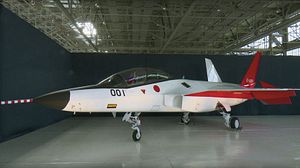Japan’s new Acquisition, Technology, and Logistics Agency (ATLA) revealed that tests of the Mitsubishi Heavy Industries experimental fifth-generation fighter technology demonstrator (ATD-X), now dubbed X-2 and unofficially named ‘ShinShin,’ are proceeding according to plan.
In an email to Flight Global, an ATLA representative said that the “[t]he aircraft is performing well so far. We are proceeding with tests, performing very careful maintenance, and making some minor adjustments.” ATLA did not divulge additional details. The tests are taking place at the Mitsubishi Heavy Industries testing center, located in Aichi Prefecture on Japan’s main island of Honshu.
Japan’s Ministry of Defense Technical Research and Development Institute (TRDI) originally announced in January 2016 that the aircraft would make its maiden flight in February of this year (See: “Japan’s 5th Generation Stealth Fighter to Make Maiden Flight in Early 2016”). However, this has not occurred and ATLA refused to name a new date for the aircraft’s first takeoff.
Delays in the development of the X-2 prototype have not been unusual; various technical problems, including issues with the engine control software, have repeatedly pushed back the testing timeline.
The X-2’s first flight is expected to take the technology demonstrator from Mitsubishi testing center in Aichi Prefecture to Gifu Air Field, an airbase of the Japan Air Self-Defense Force, situated in the neighboring prefecture of Gifu.
As I explained in January 2016 (See: “Japan Unveils New 5th Generation Stealth Fighter Jet”):
The X-2 is the country’s first domestically produced full-scale test model—a technology demonstrator—of a new indigenous stealth fighter jet design, which has been under development at a Mitsubishi Heavy Industries plant in Toyoyama since 2009, with total program costs estimated at 39.4 billion yen (around $331 million).
In addition, I noted:
The aircraft—an “advanced technology demonstration unit,” according to the Defense Technical Research and Development Institute –unveiled to the press will not be armed and is slated to be retired in three years, after having undergone extensive tests of advanced fifth-generation fighter technologies, for which Japan’s Defense Ministry has allocated 2.3 billion yen ($19.3 million) in the next fiscal year alone. It will be a testbed platform for multiple technologies including next generation electronically scanned array radar systems, multi-dimensional 3D thrust vectoring concepts, and fine-tune the aircraft’s stealth capabilities. (The X-2 features a special carbon-fiber composite material that absorbs radar waves.)
Japan currently only possesses one prototype of the aircraft. The X-2 will be the basis for the production of the country’s first indigenously-designed fifth-generation air superiority fighter, dubbed the F-3, with serial production tentatively scheduled to begin in 2027.
































